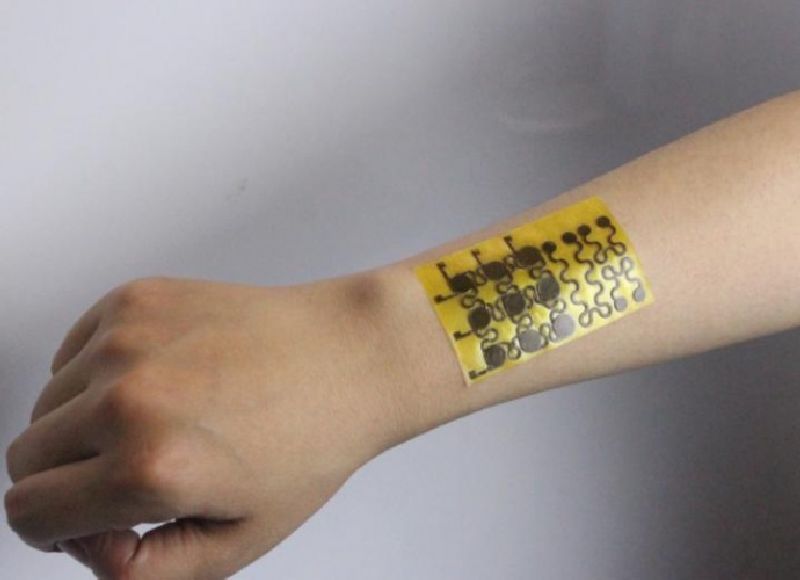Electronic skin (or e-skin,) developed by scientists of University of Colorado Boulder adds a new dimension to self-care, enabling a wider range of applications in prosthetics and biomedicine. This fully recyclable self-healing e-skin, the first of its kind, mimics the functions of human skin with its ability to measure pressure, temperature, humidity, and vibration.
The detailed study of the new material used was published in Science Advances, which also assures improving the safety of robotic care. Another significant part of this advanced version of self-healing electronic skin is its reusability – which further reduces waste generation and manufacturing cost.
Enabling sensation to the passive system:

The conventional prosthetic arm, leg, or hand – unable to feel the sensation of temperature and pressure changes – will now be able to respond to the external stimuli with the help of this new electronic skin technology.
A polymer network known as polyamine with embedded silver nanoparticles constitute e-skin, with the latter providing strength, chemical stability, and electrical conductivity. The polymer base helps to adjust with the intricately curved spaces in between toes and fingers.
According to the co-author of the study Wei Zhang, this electronic skin can prevent people from getting burnt or hurt just as the normal skin. This is considered to be e-skin’s most notable feature. If wrapped around a prosthetic hand, the person would be able to feel the pressure of holding or lifting a cup. This would help the person to apply the right amount of pressure, thereby preventing crushing of the cup.
Improving the safety aspect of robots:
Sensing becomes more important while interacting with robots to ensure that they do not end up hurting or injuring the users as expressed by Jianliang Xiao, a mechanical engineer at the University of Colorado and lead author of the study. The robots are likely to be the future babysitters and elder caregivers. The electronic skin can be wrapped on their hands which will guide them not to apply too much or too little force on the babies or elders – causing an accidental death. The robot will even be able to detect the fever of your baby just by touching it with a finger.
Self- healing electronic skin technology:

Another notable feature of electronic skin is in its self-healing technology. The damaged electronic patch can be immersed in a solution which degrades the polymer, allowing the silver nanoparticles to sink to the bottom. This can be further recycled to create a newly reusable e-skin.
Electronic skin tracks your heart:
When advanced sleek wearable in the form of fitness trackers are creating waves in healthcare, a team of engineers from the University of Tokyo has devised a unique application of electronic skin technology.
It is a new form of patient empowerment; where an ultrathin, stretchable, and breathable patch can be worn directly on the skin continuously for 7 days without causing any itching or inflammation. Made from very soft materials, it can be deformed in many ways without causing any malfunctioning of the artificial skin patch.
Nanomesh electrodes equipped in this form of e-skin can readily pick up electric signals from the heart and display the data in a simple graphic motion through a 24X16 array of micro LEDs on real-time basis enabling a continuous cardiovascular health monitoring of the patient irrespective of his/her location.
The data can be uploaded to the cloud wirelessly through a smartphone. A remotely located doctor can get the updated status of the heart patient. The patch is neither cumbersome nor will the patient face any discomfort while wearing it.
Portable electrocardiogram taking care of geriatric patients:
It is more like a portable electrocardiogram, easily operable by the patient. Being highly stretchable, this new form of artificial skin sits on the actual skin perfectly. The stretchable display is durable and maintains stability with the sensors, collecting safe as well as accurate data and display receiving reliable and safe feedback.
The engineer and the head of the research team Takao Someya is highly optimistic about its application that would help in managing the health crisis of the burgeoning geriatric population, which is considered to be one of the significant obstacles to global prosperity. Skin electronics is set to enhance medical accessibility for the elderly with severe disabilities facing difficulty in operating conventional medical devices.
This particular e-skin stands ahead of other wearable sensors as it is more user-friendly and is almost unnoticeable when worn. Undoubtedly, a long awaited solution has emerged in empowering patients in self-care that would significantly reduce the burden of nursing care.




